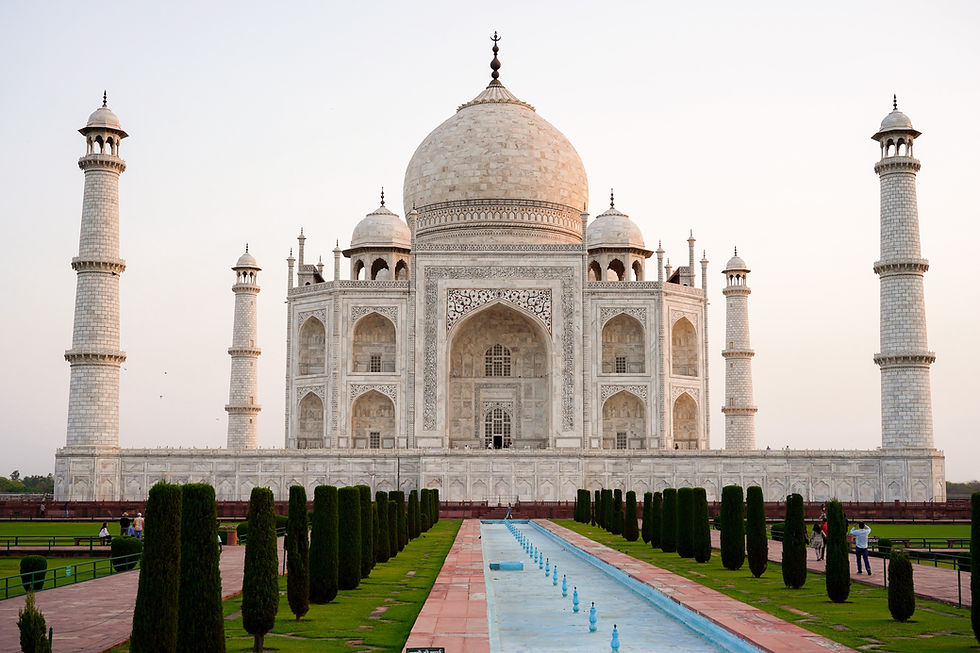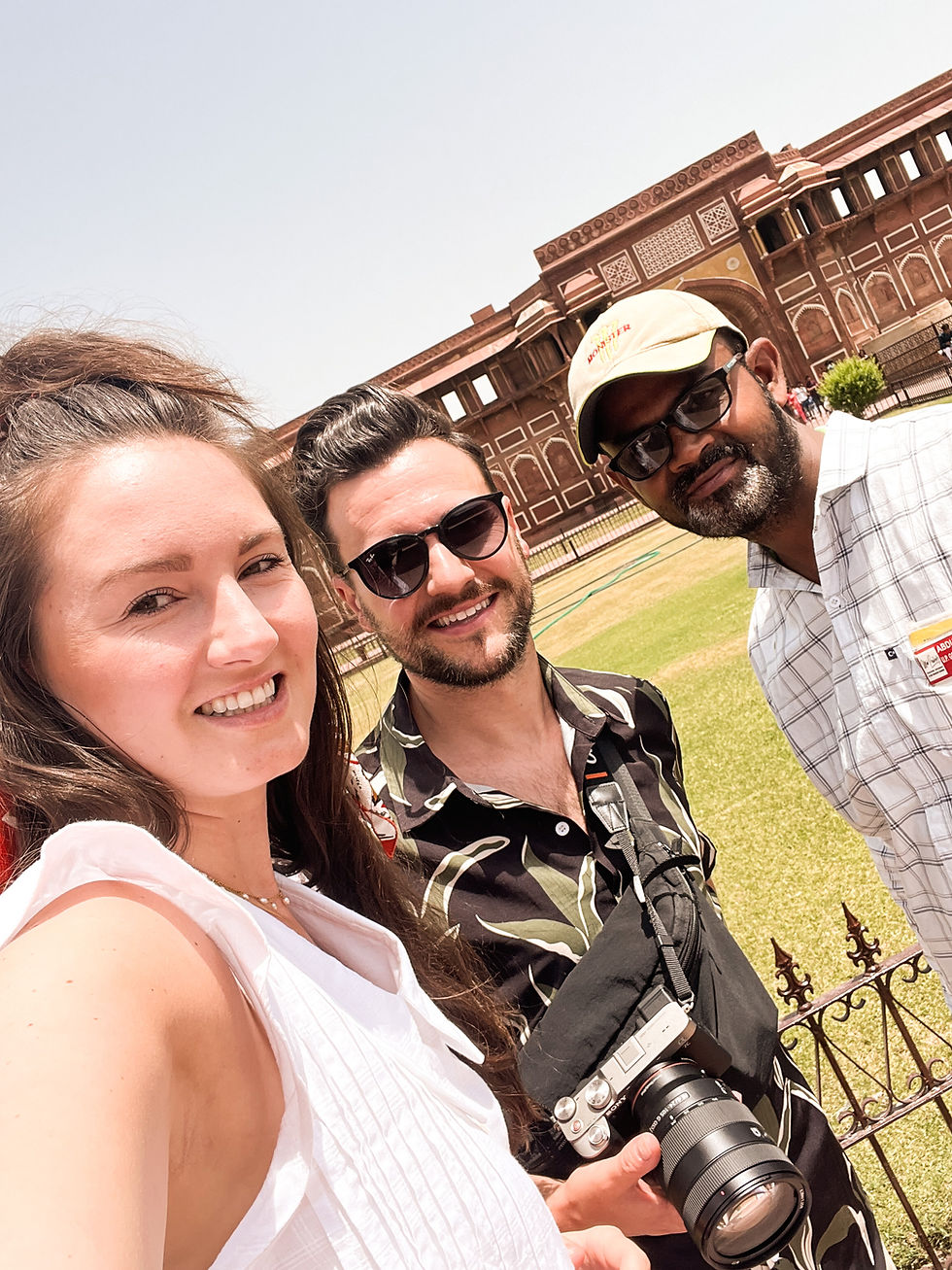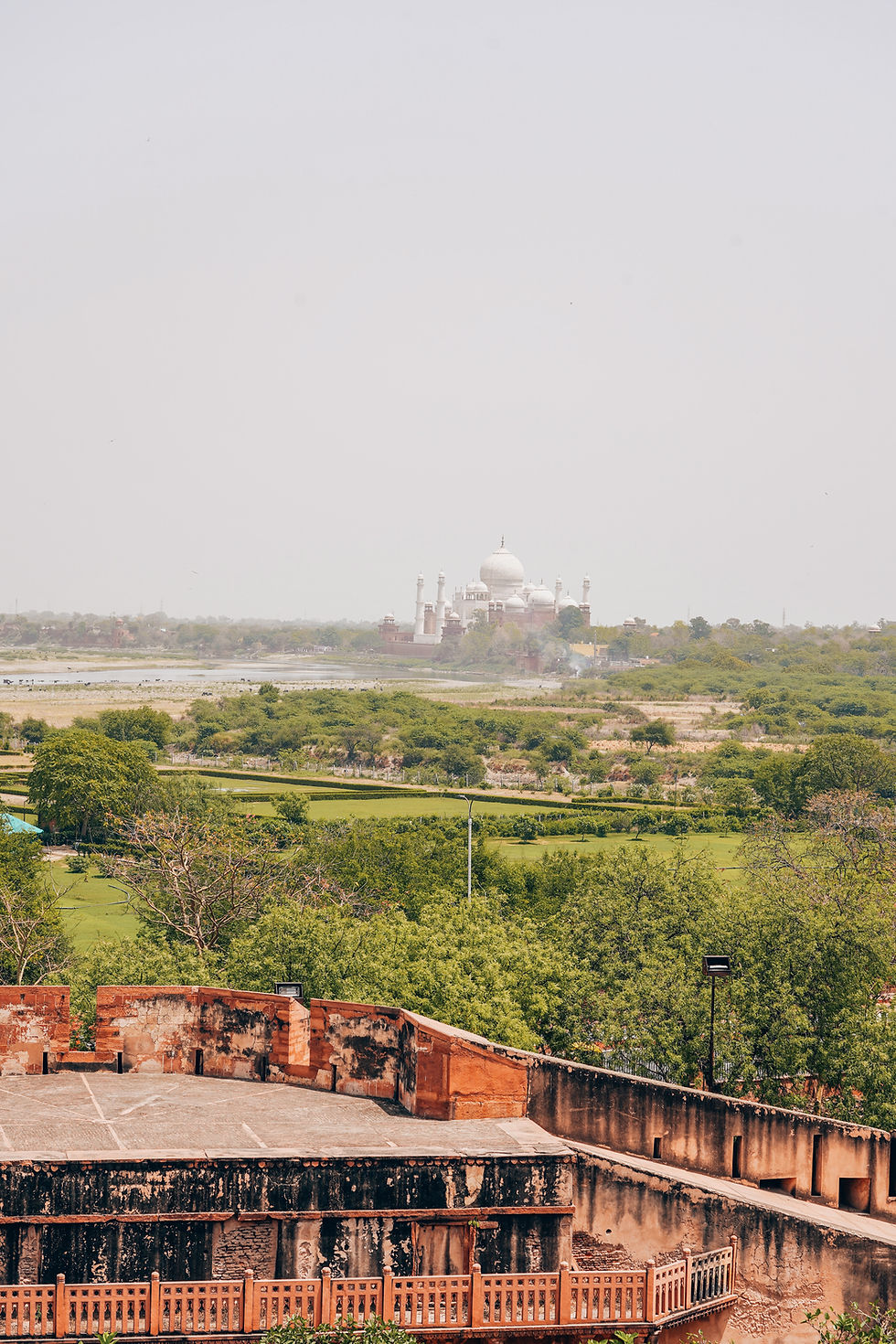How to spend 2 great days in Agra
- Patrik Jung
- May 14, 2023
- 9 min read

Agra is a city located in the northern part of India and is world-renowned for the Taj Mahal, one of the most famous tourist attractions in the world. Every year, millions of visitors from all around the world flock to Agra to see this stunning architectural masterpiece. However, Agra has much more to offer than just the Taj Mahal.
Despite being famous for the Taj Mahal, Agra has a rich history and culture that is worth exploring. There is a lot to discover and we did not see all of it, but we used the holy Friday, when the Taj Mahal was closed to get to know the rest of Agra.
Here are the top sights of Agra:
1. Taj Mahal: No trip to Agra would be complete without a visit to the Taj Mahal. This beautiful mausoleum was built in the 17th century by the Mughal emperor Shah Jahan as a tribute to his beloved wife Mumtaz Mahal.
2. Agra Fort: The Agra Fort is another must-visit attraction in the city. Built in the 16th century, this impressive fort served as the seat of the Mughal Empire for many years.
3. Fatehpur Sikri: Located just outside of Agra, Fatehpur Sikri is a well-preserved ancient city that was once the capital of the Mughal Empire.
4. Itmad-ud-Daulah's Tomb: This beautiful tomb is sometimes referred to as the "Baby Taj" due to its similar design and intricate marble work. It was built in the 17th century by Nur Jahan, the wife of the Mughal emperor Jahangir.
5. Mehtab Bagh: Located on the opposite bank of the Yamuna River, Mehtab Bagh offers a beautiful view of the Taj Mahal at sunset. The gardens were built in the 17th century and are a great place to relax and take in the view.
6. Jama Masjid: This beautiful mosque was built in the 17th century by the Mughal emperor Shah Jahan and features stunning architecture and intricate design work.
7. Akbar's Tomb: Located in Sikandra, just outside of Agra, Akbar's Tomb is the final resting place of the great Mughal emperor Akbar. The tomb is a beautiful example of Mughal architecture and is well worth a visit.
In this blog post, we'll take a closer look at some of the other attractions in Agra and why it's worth spending a little extra time exploring this fascinating city beyond the Taj Mahal and of course we start with this amazing and spectacular Wonder of the World.
The Taj Mahal: India's Iconic Monument of Love

Can you list the Seven Wonders of the World? Here we are: The New Seven Wonders of the World, as declared by the New7Wonders Foundation in 2007, are the
1. Great Wall of China
2. Petra in Jordan
3. Christ the Redeemer in Brazil
4. Machu Picchu in Peru
5. Chichen Itza in Mexico
6. Colosseum in Rome
7. Taj Mahal in India, which we can present right now.
Once upon a time, in the 17th century, the great Mughal emperor Shah Jahan fell deeply in love with his wife, Mumtaz Mahal. She was his favorite wife, and when she died during childbirth, the emperor was grief-stricken. He vowed to honor her memory by building a grand mausoleum, the likes of which the world had never seen before.
The construction of the Taj Mahal took over 20 years to complete, from 1632 to 1653. The building process was a massive undertaking that involved over 20,000 workers, including skilled craftsmen, artisans, and laborers. Despite the enormous amount of labor and resources required to build the Taj Mahal, it remains one of the most stunning and iconic structures in the world, a testament to the incredible dedication and skill of its builders.
The transportation of the marble for the Taj Mahal to Agra was a massive undertaking that involved a significant number of elephants. According to historical records, over 1,000 elephants were used to transport the white marble from the quarries in Rajasthan to Agra, a distance of around 200 miles (320 km).
The process of transporting the marble was not an easy one. The blocks of marble had to be carefully loaded onto the backs of the elephants and transported along narrow and often treacherous roads. The journey could take several months, and the elephants had to be rested and fed along the way to ensure that they remained healthy and strong.
Once the marble arrived in Agra, it was transported to the construction site by ox-drawn carts. The workers then carefully cut and shaped the marble into the intricate designs that make the Taj Mahal so famous.
The Taj Mahal's design is a blend of Persian, Indian, and Islamic architectural styles. It features intricate carvings and inlaid precious stones, including jasper and turquoise, creating a stunning visual effect. The four minarets surrounding the central dome symbolize the four corners of the earth.












The Entrance Gate of the Taj Mahal
The Taj Mahal's entrance gate is a stunning feature that frames the monument perfectly, creating an illusion that the Taj Mahal grows in size as you approach it. This effect is enhanced when you enter the main complex, standing in front of the majestic building. The architect, Ustad Ahmad Lahauri, demonstrated his masterful skills in creating this iconic entrance gate with its elaborate calligraphy, geometric patterns, and floral motifs.

After the Taj Mahal's completion in 1653, Shah Jahan was overthrown by his son Aurangzeb and imprisoned in the Agra Fort, where he spent the remainder of his life gazing out of the window at the Taj Mahal, his beloved wife's final resting place. Shah Jahan died in captivity in 1666, and his body was interred next to Mumtaz Mahal in the Taj Mahal.
On one hand, many people at the time admired the Taj Mahal's beauty and grandeur, considering it to be a symbol of the emperor's power, wealth, and love for his wife Mumtaz Mahal. The monument was also seen as a testament to the artistic and architectural achievements of the Mughal Empire. On the other hand, there were some criticisms of the monument, particularly regarding its cost and the labor that was involved in its construction. The cost of the monument was said to be astronomical, with some sources estimating it to have cost over a billion dollars in today's currency.




Here are the top 5 facts about the popularity of Taj Mahal from a touristic perspective:
1. The Taj Mahal attracts millions of tourists each year: It is estimated that the Taj Mahal receives over 7 million visitors per year, making it one of the most visited tourist attractions in India and the world.
2. It generates a significant amount of revenue for India: According to a report by the World Travel and Tourism Council, tourism in India contributes approximately $240 billion to the country's economy each year, with the Taj Mahal being a significant contributor to this revenue.
3. The Taj Mahal has been declared a UNESCO World Heritage Site: In 1983, the Taj Mahal was declared a UNESCO World Heritage Site, further cementing its place as a global icon.
4. It has been featured in numerous movies, books, and other forms of media: The Taj Mahal has been a popular subject in films, novels, and other forms of art, contributing to its global popularity.
5. The Taj Mahal is an enduring symbol of love and beauty: The story of the Taj Mahal as a monument to love has captured the hearts of people around the world, making it a powerful symbol of love and beauty.
Masjid-i Jahan-Numa - a part of the Taj Mahal area and important to know

While the Taj Mahal may be the star attraction in Agra, there is another equally remarkable structure right across from it - the stunning mosque known as the Masjid-i Jahan-Numa. Built by Shah Jahan, the mosque is an important place of worship for thousands of Muslims in India.
Despite its proximity to the Taj Mahal, the mosque often gets overlooked by tourists who flock to see the world-famous monument. But for many Muslims, the Masjid-i Jahan-Numa is a significant and cherished place of worship.
In fact, the importance of the mosque is such that the Taj Mahal remains closed to visitors on Fridays, which is the most important day of prayer for Muslims. This allows worshippers to have uninterrupted access to the mosque and the Taj Mahal complex.
So while the Taj Mahal may be the main attraction for tourists visiting Agra, it's important to remember the significance of the Masjid-i Jahan-Numa and the role it plays in the lives of many Indians.
The guys in the guesthouse shocked us for a second, giving us the information, that the sun position lead to the end of Ramadan with the impact, that Taj Mahal will open later, because there is a big muslim prayer. We would miss the sunrise and we did not plan any longer in Agra. Anyway we stood up early (and almost missed it, because we did not hear our alarm, because of the AC. We NEVER oversleep, unbelievable) and arrived on time as the sun came up. You have to be there early to see the incredible color games of the marble in the rising sunlight. Magic! And later you won‘t see the Taj Mahal anymore, because there are so many people. But even at 5am in the morning there are a lot! So we were lucky, no prayer, almost right, the prayer was later, as you can see on the mosque, which was getting crowded with Indian Muslims. You can google the prayers, this place was later completely filled with people.





Masses of people, mostly recognizable as Muslims (hats and dresses) crowded into the Taj Mahal for the big joint prayer. Fortunately we were early before the sun came up and avoided the biggest crowds and enjoyed the busy life afterwards.
Enough Taj Mahal, time to discover also the rest of Agra…
The Agra Fort - a red sandstone fortress



















Our Tour Guide with us. First, we did not want a guide, we were doing the research by ourselves, but after the 5th offering we could not say no anymore.
The Red Fort is a great place to also see the Taj Mahal, for Taj Mahal Selfies. Like this the Shah must have seen the construction site during his imprisonment:



The Baby Taj - it felt a little bit like with the big brother
The Baby Taj, also known as the Tomb of Itimad-ud-Daulah, is a beautiful mausoleum located in Agra, India. It was built by Nur Jahan, the wife of Emperor Jahangir, in memory of her father, Mirza Ghiyas Beg.
We were very surprised about the beauty of Baby Taj and had a great time with the small details of the lovely Mausoleum.










In the afternoon there was enough shadow to walk on. But I was so happy that we found the hint on a travel blog, so we give you the same: take socks with you, also valid for the other sights, in case, that the ground is so hot, that walking barefoot hurts :) No joke!






The mausoleum is often referred to as the Baby Taj due to its striking resemblance to the Taj Mahal, which was built later by Emperor Shah Jahan. The Baby Taj is also considered a precursor to the Taj Mahal and a stepping stone in the development of Mughal architecture.
The Baby Taj is known for its intricate marble inlays, elaborate carvings, and detailed artwork. It is said to have inspired the designs of the Taj Mahal and other Mughal-era buildings in India.
Despite its smaller size, the Baby Taj is a significant landmark in Agra and an important part of Indian history and architecture. It is a must-visit for anyone interested in the history and culture of the Mughal Empire.
The Tomb of Akbar in Sikandra
Akbars Tomb at Sikandra is the final resting place of Akbar the Great, one of the most prominent emperors of the Mughal dynasty in India. The tomb is located in Sikandra, a suburb of Agra, and is known for its impressive architectural features, including the fusion of Islamic, Hindu, and Jain architectural styles. The tomb complex also includes a beautiful garden and a mosque.
And this is why we took a Tuk Tuk to get to Sikandra, it takes roughly 30 minutes, definitely worth the trip. And of course it was Selfie time, already starting at the entrance gate.




Nice hat :)







His brother almost attacked me and was running after me with bared teeth as I came closer for a photo :) Uff, lucky. Sometimes they are really dangerous, even if it all starts with fun.



Another Indian Youtube Influencer and we are happy to share his channel. He proudly presented his channel, but we have no idea, if our selfies were published in the internet, so give us a hint, if you find them :)





So you see, that Agra has a lot in its portfolio. Unfortunately the city in general is not really beautiful. It‘s a typical loud indian city, partly dirty and we were surprised, that they modernize not more intensively, especially giving people better jobs to increase wealth, at this special place with one of the most profitable sights of the world. Ok, they build a city metro, but that‘s it. But the sights are in great shape, we have to highlight.
And last but not least, some impressions from our walks through Agra, if we had enough of attractions. There is always so much to see in India :)






Monkeys in Agra are an issue. Searching in the internet for Agra Monkeys we found also some articles about the challenges at the train station Agra Cantt and Indians asking the Government for help and action to reduce the number of monkeys attacking travellers. During our departure to Delhi we had them also on the platform and left some meters to avoid them stealing our drinks, food or in the worst case luggage. Sounds funny, but if they bite people, it is not really funny anymore.




Surprisingly a hair dresser shop and not a man with a scissor and a mirror on a tree (no joke, but a little fun:)



The holy cow - part of Indian life. Anywhere, anytime.

But we have no idea, where this horse was coming from.

Guys like this one are also very busy during Indian nights, when you should avoid popular dog places. They fight, you hear them barking at night very often.



Another unexpected guest. Indians love animals :)








Cafés and Restaurants on top of Agra
In the end some recommendations to eat or to drink a coffee with an amazing view of the Taj Mahal. We stayed long there and enjoyed it. It‘s magic.
1.Hotel Saniya palace Inn
2.Chia Taj View Cafe
3.The Hippie Cafe



Small boys were building paper kites and had a very loooong line (check it on the picture)! It was a great boys challenge on Agras rooftops, these kites were everywhere, partly in the wheels of scooters or on heads of tourists, but it was remarkable how high the guys let them fly.




Comments